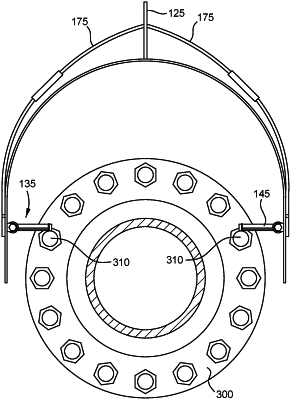| CPC F16L 1/123 (2013.01) [F16L 23/02 (2013.01)] | 20 Claims |

|
1. A shroud, comprising:
a cover structure; and
a plurality of retaining members coupled to an interior surface of the cover structure, wherein each of the plurality of retaining members comprises:
an arm coupled to a hinge and a spring, the spring utilized to temporarily fix the arm in a position that is substantially orthogonal to a plane of the interior surface, wherein the hinge allows movement of the arm in a first direction and temporarily prevents movement of the arm in a second direction opposite to the first direction.
|
|
16. A method for attaching a shroud to a flange of a pipeline, the method comprising:
lowering a cover structure toward the flange such that a plurality of arms coupled to and extending from an interior surface of the cover structure contact one or more studs extending from the flange, wherein each of the plurality of arms are coupled to a spring that provides a bias to the respective arms in a first direction and a first position; and
continually lowering the cover structure to substantially surround the flange such that a weight of the cover structure during the lowering overcomes the bias of the spring allowing the plurality of arms to move to a second position in a second direction opposite to the first direction and past the one or more studs, wherein each of the plurality of arms move in the first direction to return to the first position after the respective rod passes a stud.
|